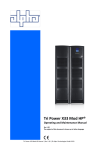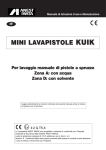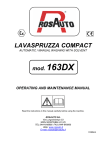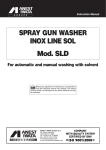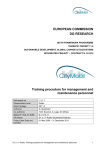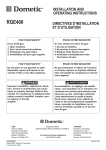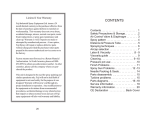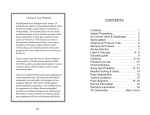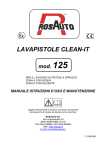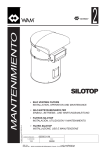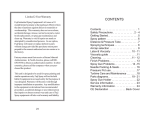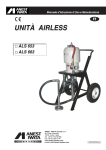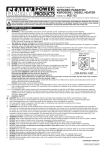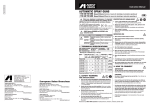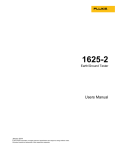Download MINI GUN WASHER KUIK
Transcript
Instruction Manual GB MINI GUN WASHER KUIK For manual washing of spray guns Zone A: with Water Zone D: with Solvent Before use, adjustment or maintenance, it is important to read this instruction manual very carefully. The manual must be stored in a safe place for any future reference that may be necessary. This ANEST-IWATA Gun Washer complies to ATEX regulations 94/9/EC. Protection level: II 2 GX Suitable for use in Zones 1 and 2. X marking: Any static electricity discharge from the pump is to be diverted to the ground through the grounding wire which is included in this product. AI SENSI DELLE DIRETTIVE 94/9/CE – 2006/42/CE IN COMPLIANCE WITH THE 94/9/CE – 2006/42/CE DIRECTIVES NOI: THE UNDERSIGNED: ANEST IWATA Europe S.r.l. C.so Vigevano, 46 10155 TORINO – ITALIA DICHIARIAMO SOTTO LA NOSTRA ESCLUSIVA RESPONSABILITÀ CHE LA LAVAPISTOLE PER AEROGRAFI ED ACCESSORI DENOMINATA: HEREBY DECLARES UNDER ITS OWN RESPONSIBILITY THAT THE WASHER FOR SPRAY-GUNS AND ACCESSORIES HEREUNDER REFERRED TO AS: LAVAPISTOLE: SPRAY-GUN WASHER: MOD.: KUIK KUIK KUIK SERIES N°: Classificazione apparecchio secondo Direttiva 94/9/CE Equipment classified in compliance with Directive 94/9/CE Gruppo II Categoria 2 - G - T5 ATEX: Group II Category 2 - G - T5 AL QUALE QUESTA DICHIARAZIONE SI RIFERISCE E’ CONFORME AI REQUISITI ESSENZIALI DI SICUREZZA E SALUTE E ALLE SEGUENTI DISPOSIZIONI LEGISLATIVE: WHICH THIS DECLARATION REFERS TO, COMPLIES WITH THE FOLLOWING RULES ALREADY IN FORCE: DIRETTIVA 2006/42/CE (SICUREZZA MACCHINE) DIRECTIVE 2006/42/CE (MACHINERY SAFETY) DIRETTIVA 94/9/CE (SICUREZZA ATMOSFERE POTENZIALMENTE ESPLOSIVE) DIRECTIVE 94/9/CE (SAFETY IN POTENTIALLY EXPLOSIVE ATMOSPHERES) PER LA VERIFICA DELLA CONFORMITÀ ALLE DISPOSIZIONI LEGISLATIVE SONO STATE APPLICATE LE SEGUENTI NORME ARMONIZZATE: COMPLIANCE WITH LEGAL PROVISIONS IS GUARANTEED BY THE APPLICATION OF THE HARMONISED REGULATIONS HERE BELOW: EN 349-1 :1993+A1 :2008, EN 626-1 :1994+A1 :2008, EN 842 :1996, EN 1037 :1995+A1 :2008, EN 11271 :2007, EN 4414 :2010, ISO 7000 :2012, EN ISO 3746 :2010, EN ISO 11202 :2010, EN ISO 121001 :2003, EN ISO 12100-2 :2003, EN 12921-1 :2005+A1 :2010, EN 12921-2 :2005+A1 :2008, EN 129213 :2005+A1 :2008, EN ISO 13849-1 :2009, EN ISO 13857 :2008, EN ISO 14121-1 :2007 Dr. Marco G. Vicentini Torino, ____________________ ____________ ___________________ (Data) (Firma del legale rappresentante) Il fascicolo compilato ai sensi dell’art. 8, paragrafo 1, lettera b), sottolettera ii) della direttiva 94/9/CE ATEX, è stato trasmesso all’organismo notificato di seguito indicato. - Name and address of the Notified Body: I.C.E.P.I. S.p.a. Istituto Certificazione Europeo Prodotti Industriali Via Paolo Belizzi, 29/31/33 - 29100 PIACENZA – ITALIA N. IDENTIFICATIVO: Numero della DICHIARAZIONE DELLA RICEVUTA DI DEPOSITO: MINI GUN WASHER KUIK TABLE OF CONTENTS 1 1.1 1.2 1.2.1 1.2.2 1.3 1.4 1.5 2 2.1 2.2 2.3 2.4 3 3.1 3.2 3.3 3.4 3.5 4 5 5.1 5.2 6 6.1 6.2 6.3 7 8 8.1 9 9.1 9.2 9.3 10 11 INTRODUCTION................................................................................................................................................ 3 CE CERTIFICATION OF GUN WASHER.......................................................................................................... 3 APPLICATION ................................................................................................................................................... 4 PERMITTED USES ........................................................................................................................................... 4 IMPROPER USES ............................................................................................................................................. 5 EXPOSURE AREA ........................................................................................................................................... 5 WASHING PRODUCTS......................................................................................................................................5 FORBIDDEN WASHING PRODUCTS................................................................................................................6 GENERAL RULES FOR SAFETY AND ACCIDENT PREVENTION ...............................................................6 LEVELS OF DANGER AND TERMINOLOGY ...................................................................................................6 CLOTHING ........................................................................................................................................................ 8 ECOLOGY AND POLLUTION ...........................................................................................................................8 DISMANTLING AND PUT OUT OF SERVICE ..................................................................................................8 DESCRIPTION................................................................................................................................................... 8 PRODUCT IDENTIFICATION (see FIG.1) ......................................................................................................11 TECHNICAL SPECIFICATIONS ......................................................................................................................11 SOUND LEVEL................................................................................................................................................ 11 DANGER SIGNS AND WARNING SIGNALS...................................................................................................12 STANDARDS FOR SAFE USE .......................................................................................................................13 SHIPMENT AND UNLOADING .......................................................................................................................14 POSITIONING ................................................................................................................................................. 14 CHECKS BEFORE INSTALLATION ................................................................................................................14 INSTALLATION ................................................................................................................................................14 INSTRUCTIONS FOR USE ..............................................................................................................................15 PREPARATION FOR THE USE OF THE GUN WASHER ...............................................................................15 GUN WASHING, IN ZONE A (WATER), (see FIG.1) .......................................................................................15 GUN WASHING, IN ZONE D (SOLVENT), (see FIG.1) ..................................................................................15 SAFETY DEVICES ..........................................................................................................................................15 HYDRO-PNEUMATIC SYSTEM ......................................................................................................................16 OPERATION .................................................................................................................................................... 16 MAINTENANCE AND PERIODICAL CHECKS ...............................................................................................17 INSUFFICIENT VAPOURS EXHAUST (see ref.15 FIG.1) ..............................................................................17 VENTURI PUMP CLEANING ..........................................................................................................................17 NEBULIZER CLEANING .................................................................................................................................17 SPARE PARTS LIST .......................................................................................................................................18 GUARANTEE................................................................................................................................................... 19 ANEST IWATA EUROPE srl reserves the property of the following manual. Any reproduction or disclosure of this manual without prior approval by the owner is expressly prohibited. For any claims, accidents or the like, the legally approved text will be the one in the manufacturer's language. ANEST IWATA EUROPE srl WAIVES any and all liabilities for damages by misinterpretations or incorrect use caused by imperfect or imprecise translations. 2 MINI GUN WASHER KUIK 1. INTRODUCTION This manual contains instructions for the installation, use and maintenance of the Gun Washer KUIK. In the following manual, the cleaning equipment will be referred to as Gun Washer. This manual is an integral part to the product and should be kept with the due care in order to allow for its use and consultation during the life of the Gun Washer. The regular operation, economy and safety of the Gun Washer depends on the compliance with the instructions given in this manual. It is mandatory to follow the procedures as described in this manual: This manual must be read and understood perfectly prior to installing, using or performing any type of operation or maintenance on the machine. Use of the Gun Washer for processing other than the type indicated in this manual is considered improper use and is therefore prohibited. ANEST IWATA EUROPE declines any and all responsibilities for damages caused by the Gun Washer to persons, animals or property, due to use other than the use described herein, or for damages due to negligence or failure to observe the instructions contained in this manual. The Gun Washer is manufactured according to the provisions contained in the following European Directives: • Directive 2006/42/CE (Machine Safety). • Directive 94/9/CE (Equipment to be used in potentially esplosive environments). With reference to the Directive 94/9/CE (“ATEX” directive) the Gun Washer is a machine designed and built to work in compliance with the operating parameters fixed by ANEST IWATA EUROPE and guarantees a normal level of protection in regard to the appliances group II, category 2 G. The machine supplied is accompanied by the following documents: • Manual for use and maintenance. • CE Declaration of conformity. • CE Mark. 1.1 CE CERTIFICATION OF GUN WASHER On 29 December 2009, Directive 2006/42/CE - which is the result of the previous directives on machine safety - repealed directive 98/37/CE, and stresses the minimum requirements machinery must be brought in line with in order to be placed on the European Union market. All machinery covered by this Directive may be placed on the market and put into service only if they do not endanger the health and safety of persons, domestic animals or property. The Gun Washer is a machine designed and built to wash sprayguns or small parts, and is not included in any of the categories indicated in the list attached to the Directive (Annex IV - highly dangerous machinery). Prior to placing its machines on the market and in order to demonstrate that the machines are in compliance with the provisions set forth by Directive 2006/42/CE, ANEST IWATA EUROPE has implemented the procedure under article 5, and, in this sense, ensures that the relevant safety requirements are complied with; the technical file required by Annex VII-A is available; all tests and controls required by the reference regulations have been conducted and meet the essential safety and health requirements as provided for by Annex I of the aforementioned Directive. The technical construction file that includes the fundamental project data and all the specifications relating to the machine safety has been drawn in compliance with Annex VII-A, and is made available to any controls by the inspection authorities - prior to detailed notification, as provided for by the ruling provisions in this matter. Given that the machine has been designed and built in compliance with the provisions set forth by directive 2006/42/CE, and can be safely operated under the conditions stated by this manual, ANEST IWATA EUROPE puts the Gun Washer on the market provided with: CE Mark - CE Declaration of Conformity - Instructions for use (User's Manual) The Directive 94/9/CE defines the minimum conditions required to design, build and put on the European Union market a machine to be operated in an environment where there might form potentially explosive atmospheres. The above Directive includes the measures that must be adopted to operate the machine preventing any ignition sources or causes of potentially explosive atmosphere. According to Directive 94/9/CE, the Gun Washer is a device of group II, category 2 G, and can be safely operated in environments with potentially explosive atmospheres classified in Zone 1. ANEST IWATA EUROPE has conducted all the controls and tests required and has submitted all the requested documentation to the notified body as provided for by art. 8, para. 1, letter b), under-letter ii) of Directive 94/9/CE. For this reason, the ANEST IWATA EUROPE guarantees that the Gun Washer complies with the following directives given that its design and construction comply with the requirements provided for by the legal provisions referring to this matter: Directive 94/9/CE (ATEX) - Directive 2006/42/CE (Machine safety). 3 MINI GUN WASHER KUIK The following European standards and technical norms have been used by the manufacturer and can be a reference in order to verify the conformity with the legal European provisions: - EN 349-1:1993+A1:2008: SAFETY OF MACHINERY - Minimum distances to avoid crushing of parts of the human body. - EN 626-1:1994+A1:2008: SAFETY OF MACHINERY - Reduction of risks to health from hazardous substances emitted by machinery. Part 1: Principles and specifications for machinery manufacturers. - EN 842:1996: SAFETY OF MACHINERY - Visible signs of danger - General Requirements for design and testing. - EN 1037:1995: + A1: 2008 SAFETY OF MACHINERY - Prevention of unexpected start. - EN 1127-1:2007: EXPLOSIVE ATMOSPHERE - Explosion prevention and protection - Part 1: Basic concepts and methodology. - EN 4414-:2010: PNEUMATIC - General rules and safety requirements for systems and their components. - ISO 7000:2012: GRAPHICAL SYMBOLS FOR USE ON EQUIPMENT - Registered symbols. - EN ISO 11202:2010: ACOUSTICS - Noise emitted by machinery and equipment - Measurement of emission sound pressure levels at a work station and at other specified positions - Survey method in site. - EN ISO 12100-1:2003: SAFETY OF MACHINERY - Basic concepts, general principles for design - Part 1: Basic terminology, methodology. - EN ISO 12100-2:2003: SAFETY OF MACHINERY - Basic concepts, general principles for design - Part 2: Technical principles. - EN 12921-1:2005:+A1:2010: Machines for surface cleaning and pretreatment of industrial items using liquids or vapours Part 1: Common safety requirements. - EN 12921-2:2005+A1:2008: Machines for surface cleaning and pre-treatment of industrial items using liquids or vapours Part 2: Safety of machines using water-based cleaning liquids. - EN 12921-3:2005+A1:2008: Machines for surface cleaning and pre-treatment of industrial items using liquids or vapours Part 3: Safety of machines using solvent-based cleaning liquids. - EN ISO 13849-1:2009: SAFETY OF MACHINERY - Safety-related parts of control systems - Part 1: General design principles. - EN ISO 13857:2008: SAFETY OF MACHINERY - Safety distances to prevent hazard zones being reached by upper and lower limbs. - EN ISO 14121-1:2007: SAFETY OF MACHINERY - Risk assessment - Part 1: Principles. 1.2 APPLICATION 1.2.1 PERMITTED USES The Gun Washer is a common appliance for bodyshops where it is mainly used to clean spray guns with their components: cups, lids and other little accessories related to them, such as empty cans from the paint, containers for paint preparation, filters and sticks for stirring, using water, water-based detergent or mixture of solvents having certain characteristics (see section 1.4 WASHING PRODUCTS). When is used a water-based detergent it must have a pH between 6.5 and 12 with a percentage of flammable components not exceeding 8%. • Use in environments with potentially explosive atmospheres. The Gun Washer has been designed and built by ANEST IWATA EUROPE in order to guarantee a high level of protection, efficient operations and conformity to the working parameters provided for devices group II, category 2 hazard type G (gas) in explosive atmospheres caused by gas, vapour or mist in compliance with Directive 94/9/CE (ATEX). The Gun Washer is fitted with protection systems that guarantee the required level of protection also when recurring troubles or working faults of the appliance itself are expected. 4 MINI GUN WASHER KUIK Thanks to such a design and manufacture, the Gun Washer can be used in environments where the atmosphere is potentially explosive. Environments are classified according to the following risk areas (Directive 1999/92/CE). • ZONE 1: Area in which - during normal working activities - is likely to form an explosive atmosphere which consists of a composition of air and flammable substances in form of gases, vapours or mists. The machine can obviously operate in the areas in which the risk of explosion is lower, such as in ZONE 2. 1.2.2 IMPROPER USES The Gun Washer has been built in such a way that improper operations might be carried out. Under improper use the producer means and includes - to his sole discretion - all uses of the Gun Washer that may cause danger and/or damage to heath of persons, animals and/or damages to the machine. Some reasonably expectable improper uses are listed here below as an example: • Mix water and solvent, during washing operation. • Washing and de-greasing objects destined to come in contact with food products. • Operating and/or soaking incandescent metal parts. • Washing animals. • Washing personal belongings. • Lighting fires inside the Gun Washer. • Washing plastic materials with solvent. • Using the Gun Washer in environments where potentially explosive atmospheres generated by gas, vapour, mist, classified <Zone 0> in compliance with Directive 1999/92/CE. • Using the Gun Washer in environments where are present atmospheres of flammable air and dusts. The Gun Washer must be used exclusively for the purpose for which it was designed and built. All other uses not covered by this manual are to be considered inappropriate and are strictly forbidden. ANEST IWATA EUROPE declines any and all responsibility for damage to persons, animals and property deriving from improper use of the Spray Gun Washer and/or from failure to observe the instructions in this manual. 1.3 EXPOSURE AREA When solvents and flammable products in general are used for washing, the Spray Gun Cleaner generates a hood-like area of potentially explosive atmosphere caused by the mixture of flammable vapours contained in the products themselves and the environmental air. The diagram below illustrates the area exposed to potentially explosive atmosphere in average ventilation conditions. As a general rule, working equipment cannot be operated inside this type of areas unless they are design and built and mandatorily fitted with protection devices in compliance with Directive 94/9/CE (Atex). In particular: • Zone 1 - inside the area at an operating distance of 1 meter from the machine working equipment must comply with group II - category 2 G (gas). • Zone 2 - inside 1-meter area at an operating distance of 1 meter from Zone 1 working equipment must comply with group II - category 3 G (gas). The user, as provided for by Directive 1999/92/CE, must ensure that the dangerous area illustrated by the figure is respected, and the work environment where potentially explosive atmospheres are likely to occur is opportunely classified. 1.4 WASHING PRODUCTS The use of the gun washer is designed to perform the operations of washing in two distinct zones (see Figure 1): A zone for washing with water and / or water-based detergent; zone D for washing with a mixture of diluents . In the specific use for washing: ZONE A: Water wiht ANEST IWATA detergent “REMOVER”or water-based detergent. The compound technical specifications must include: pH ranging from 6.5 to 12; lack of flammable components or with a share not over 8 %. 5 MINI GUN WASHER KUIK ZONE D: The solvent washing mixture as customary used by bodyshop for solvent-based paint parts usually contains: • Acetone, methyl acetate, carbinol, methyl cyanide, propyl chloride, dichloroethene, hexane, Isopropyl alcohol, M.E.K. (methyl ethyl ketone), methyl acetate, propylene . • Hydrocarbon, gas oil, kerosene-based solvent. The above washing products must comply with the legal prescriptions set forth against environmental pollution in force in the Country where the Gun Washer is used. 1.5 FORBIDDEN WASHING PRODUCTS The use of products not recommended by the producer may endanger health, compromise safety during operations or damage the machine. This is the reason why, it is forbidden to use products not listed in this manual. As a general yet not exhaustive rule, here below you may find some products that are commonly used in bodyshops but are forbidden when operating the Gun Washer: • Petrol and its by-products. • Ethyl alcohol and other primary alcohol products. • Non-flammable solvents but health dangerous (chloride, chlorinated or fluorocarbon solvents), such as thricloromethane, trichloroethane, metyl chloride, freon, carbon tetrachloride, perchloroethylene, chlorothene, trichloroethylene, etc.. DANGER It is forbidden to mix water with solvent: any washing product should only be used in the work zone assigned. DANGER It is forbidden to use solvent composed of toxic substances such as chlorides, fluorocarbons or other halogenated hydrocarbon-based substances dangerous for your health: use only products recommended by the producer. ANEST IWATA EUROPE waives any and all liabilities for damages to persons and/or animals caused by the use of improper or forbidden products when operating the Gun Washer, as detailed in this manual. 2. GENERAL SAFETY AND ACCIDENT PREVENTION REGULATIONS 2.1. LEVELS OF DANGER AND TERMINOLOGY The safety of both the operator and the persons exposed to the machinery is the primary concern of the designer and builder of the machine. In designing a new Gun Washer, every attempt is made to prevent any possible situations of danger and risks connected with use of the machine, by applying the appropriate solutions to make the equipment as safe as possible. It is therefore recommended that you read this manual carefully, especially this section, which concerns the safety norms, and that you avoid inopportune behaviour or behaviour that is contrast with the instructions contained herein. Pay attention to danger signals when these are indicated in this manual. Comply with all safety regulations. There are three danger level signals: DANGER This signal warns that incorrectly executed procedures can cause severe harm, death or long-term health risks. This is the maximum risk warning. 6 MINI GUN WASHER KUIK CAUTION This signal warns that incorrectly executed procedures can cause damage to the machine. The hazard level is lower than the previous one (danger). WARNING Read the following instructions carefully. Failure to apply them can cause harm to the machine operator, other persons, animals or property. ANEST IWATA EUROPE declines all liability for damages caused by failure to comply with the following safety and accident prevention rules and regulations. ANEST IWATA EUROPE further declines all liability for damage caused by improper use of the Gun Washer and/or caused by adjustments carried out without the manufacturer's authorization. TERMINOLOGY: The following definitions are provided for the terminology used in this manual. • DANGER: a potential source of injury or damage to health (Art. 1.1.1., letter a) attachment I, Directive 2006/42/CE). • RISK: combination of the probability and severity of an injury or damage to health that can arise in a dangerous situation (Art. 1.1.1., letter e), attachment I, Directive 2006/42/CE). • DANGEROUS AREA: any area next to or inside the machine, where the presence of an exposed person constitutes a risk for the safety and health of said person (Art. 1.1.1., letter b), attachment I, directive 2006/42/CE). • EXPOSED PERSON: any person next to or inside a dangerous area, for any reason whatsoever (Art. 1.1.1., letter c), attachment I, directive 2006/42/CE). • OPERATOR: In a general sense, the person in charge of transporting, installing, adjusting, operating, cleaning and performing ordinary maintenance on the Gun washer (Art. 1.1.1., letter d), attachment I, directive 2006/42/CE). • INTENDED USE: the use of the machine in accordance with the information provided in the instructions for use (Art.1.1.1, letter h) attachment I, directive 2006/42/CE). • REASONABLY FORESEEABLE MISUSE: the use of machinery in a way different from the one indicated in the instructions for use, but which may result from readily predictable human behavior (Art. 1.1.1, letter i) attachment I, directive 2006/42/CE). • USER: the person, organisation or company responsible for the training of workers who must operate the equipment, which has purchased the Gun Washer in any form or has rented the equipment, which must be used only for the purposes intended by the manufacturer. • SPECIALISED TECHNICIAN: an especially trained and qualified person to perform maintenance intervention or repairs, which require special in-depth knowledge of the machine, its operation, safety devices, dangerous areas and methods of intervention, who is therefore capable of recognising and avoiding dangers arising from use of the machine. • AREAS AT RISK OF EXPLOSION: an area in the environment where the Gun Washer is operated, where atmospheres with a mixture of gas or explosive vapours could develop under certain atmospheric conditions (Art. 7, directive 1999/92/CE). • ZONE 1: an area in which the formation of an explosive atmosphere, consisting of a mixture of air and flammable substances in the form of gas, vapour or mist, is likely to occur in normal operation occasionally (Attachment I, directive 1999/92/CE). • EXPLOSIVE ATMOSPHERE: a mixture of air under atmospheric conditions, with flammable substances in a gaseous state, vapours or mists, whose combustion after ignition propagates together with the unburnt mixture (Art. 1, para 3, letter c), directive 94/9/CE). • POTENTIALLY EXPLOSIVE ATOMOSPHERE: atmosphere which is likely to transform into an explosive atmosphere due to local operational conditions (Art. 1, para 3, letter c), directive 94/9/CE). • FLAMMABLE SUBSTANCE: a liquid preparation having a flame or ignition point equal to or greater than 21° C and lower or equal to 55° C (directive 67/548/CE). • pH: measurement that expresses the acidity of a solution. The pH scale ranges from 0 to 14. For pure water the pH value = 7. When pH is above 7 the solution in alkaline; when it is less than 7 the solution is acid. 7 MINI GUN WASHER KUIK 2.2 CLOTHING The type of clothing depends on the work that must be carried out. When using the Gun Washer and relevant products, comply with the regulations below: • • • • • It is forbidden to use cell phones in environments where a mixture of flammable gasses or vapours may be present. It is advisable not to have a cell phone with you. If you have a cell phone with you, it must be turned off. The operator must wear solvent-proof rubber gloves to prevent contact between his hands and the products used for washing. The operator must always wear protective eyewear to prevent the solvent coming into contact with his eyes. The operator must use a protective mask to avoid inhaling gas and dust. It is mandatory that all operators within the risk area where an explosion may occur wear suitable clothes and shoes that prevent any accumulation of dangerous electrostatic charges. 2.3 ECOLOGY AND POLLUTION • Comply with Laws in the country where the Gun Washer is installed regarding use and disposal of washing products. Comply with the recommendations given by the manufacturer of these products. 2.4 DISMANLING AND PUT OUT OF SERVICE Upon demolition or decommissioning of the Gun Washer, we recommend that you take the necessary precautions to avoid danger to exposed persons and the risk of environmental pollution: • Disconnect the Spray-gun cleaner from the pneumatic energy source and discharge the residual energy accumulated. • Residual liquid possibly left in the sink and hoses of the equipment must be carefully drained. • The other parts of the Spray-gun cleaner must be treated in accordance with the regulations for special waste. Proceed by disassembling the machine: group the various units and parts into homogeneous lots and provide for their disposal separately, in accordance with environmental protection laws in the country where the machine is installed. In general, please bear in mind that: • Plastic or rubber parts are special waste. • Ferrous scrap and carpentry are special waste. 3. DESCRIPTION With reference to Figure 1, the Gun Washer consists of a stainless steel structure in which there are two separate work areas : IN ZONE A with water, a venturi pump (ref. 21A) controlled by a switch (ref.17A) sucks dirty water and detergent from the tank (ref.27A). A nebulizer (ref. 22A) controlled by a switch (ref.18A) sucks clean detergent from tank ( ref. 28A ). The residue that falls on the worktop (ref. 6) or that is sprayed toward the slits (ref. 5) is collected from the drain hose (ref. 26A). IN ZONE D with a solvent , a venturi pump (ref. 21D) controlled by a switch (ref.17D) sucks dirty solvent from tank (ref.27D). A nebulizer (ref. 22D) controlled by a switch (ref.18D) sucks clean solvent from the tank (ref.28D). The residue that falls on the worktop (ref. 6) or that is sprayed toward the slits (ref. 5) is collected from the drain hose (ref. 26D). The gun washer is provided with a washing brush (ref. 36) to rub and remove residue from spray gun and a blow gun (ref. 5A) for the final drying . It is possible to connect the guns to wash to the air feed connection at low pressure (ref. 5D) in order to release the paint passages from residues. A switch (ref. 41) controls the blower nozzle (ref.15) that through the vapour exhaust pipe (ref.16) that suctions vapours from the work areas . The collecting tank (ref. 47) collects the solvent in the case that the containers are damaged . It is possible to hang the Gun Washer to the wall by using the four holes (ref. 80). 8 MINI GUN WASHER KUIK From the control board, the operator can control: • • • • • Venturi Pump control of dirty water and detergent through the switch (ref.17A) Nebulizer control of clean water and detergent through the switch (ref.18A) Venturi Pump control of dirty solvent through the switch (ref.17D) Nebulizer control of clean solvent through the switch (ref.18D) Suction vapours control through the switch (ref. 41) Description (see fig. 1): • • • • • • • • • • • • • • • • • • • • • • • • • • • • • • • • • • • • • • • 4A 4D 5A 5 5D 6 9 10A 10D 11 12 15 16 17A 17D 18A 18D 21A 21D 22A 22D 23A 23D 24A 24D 25 26A 26D 27A 27D 28A 28D 36 41 46 47 72 74 80 Blowing gun supply air hose Low pressure supply air hose Blowing gun Vapour and air conveyor with slits Quick joint gun connection Worktop Inner pressure regulator Outlet fitting compressed air Outlet fitting compressed air Lower door Air inlet fitting with filter Vapour suction nozzle Vapour exhaust stack Control Venturi pump switch (dirty water) Control Venturi pump switch (dirty solvent) Control atomizer switch (clean water) Control atomizer switch (clean solvent) Venturi Pump (dirty water and detergent) Venturi Pump (dirty solvent) Nebulizer (clean water and detergent) Nebulizer (clean solvent) Nebulizer supply hose zone A Nebulizer supply hose zone D Venturi pump supply hose zone A Venturi pump supply hose zone D Worktop grille Drain hose zone A Drain hose zone D Tank of dirty water and detergent Tank of dirty solvent Tank of clean water and detergent Tank of clean solvent Washing brush Control switch vapours suction Inspection cover Collecting tank Control panel label External ground cable Wall fixing holes 9 MINI GUN WASHER KUIK Figure 1 To ordering parts, see "SPARE PARTS LIST" and always indicate: THE MODEL - SERIAL NO and YEAR 10 MINI GUN WASHER KUIK 3.1 IDENTIFICATION (See fig. A) Every Gun Washer has a CE identification plate that shows: A - Manufacturer's brand. B - Manufacturer's name and address. C - CE Mark. D - Amount of washing product. E - Year of manufacture. F - Serial number G - Model. H - Maximum Pressure. N.B.: The H - G - F data listed in the identification plate must be always specified when calling for service and/or supply of spare parts. B A C H D G E F Fig. A 3.2 TECHNICAL SPECIFICATIONS Description Mass (Weight) Height Width Depth Capacity of each single tank (ref.27 e 28 fig.1) Diameter of intake nozzle holes (ref.15 fig.1) Diameter of the vapour exhaust stack (ref.16 fig.1) Max. air inlet pressure Supply air operating pressure Working pressure of pneumatic feeding Drums used in the machine base (ref.27 e 28 fig.1) Air speed at suction hood entrance (at 8 bar) 15 840 450 280 5 1,5 80 10 6 ÷ 10 8 4 0,52 kg. mm mm mm litres mm mm bar bar bar m/sec. 3.3 SOUND LEVEL The sound level emitted by the Gun Washer has been measured under working conditions using a sound level meter with integrator. Measures were taken by a skilled laboratory technician in accordance with EN ISO standard 3746: 2010. Results are as follows: • Acoustic pressure equivalent average level: • Acoustic pressure level at the operating post: • Conventional acoustic pressure level: LpAm = 72,5 dB (A). LpA = 82,9 dB (A). LwA = 85,9 dB (A). 11 MINI GUN WASHER KUIK 3.4 DANGER SIGNS AND WARNING SIGNALS The Gun Washer carries the manufacturer's identification plate as well as symbols (labels) that warn against residual hazards present on the machine. Figure 2 indicates the positions of the Manufacturer's identification plate and the warning signs. The signs have the following meanings: 1) Manufacturer's brand. CE Mark, Model, Serial number and Year of Manufacture, Maximum pressure, Danger Group, Class, Type in compliance with the “ATEX” Directive Group, Amount of washing product. 2) Generic hazard. 3) It is mandatory to read carefully the instruction manual before starting work with the Machine. 4) It is forbidden to use open flames and smoke near the machine. 5) It is mandatory to wear a protective mask before you start working. 6) It is mandatory to wear anti-solvent rubber gloves before start to work with the machine. 7) It is mandatory to wear protective glasses before start to work with the machine. 8) It is mandatory to disconnect the compressed air supply before starting any maintenance or repair operations in the machine. 9) It is mandatory to ensure that the hoses are well fitted in the drum. 10) It is mandatory to check periodically the diluent level in the drums, to avoid overflows. 11) In the zone A of the machine it is mandatory to use only water with washing detergent. WARNING: (REMOVER) • ALWAYS USE WATER AND DETERGENT • USARE SEMPRE ACQUA CON DETERGENTE • IMMER NUR WASSER MIT REINIGUNGSMITTEL VERWERDEN • UTILISER TOUJOURS L’EAU AVEC LE DETERGENT • UTILICE SIEMPRE AGUA CON DETERGENTE • UTILIZAR SEMPRE AGUA COM DETERGENTE Figure 2 12 MINI GUN WASHER KUIK 3.5 STANDARD FOR SAFE USE The Gun Washer was designed and built to be used in an environment in which can be present an explosive atmosphere, consisting of a mixture of air and flammable substances in the form of gas, vapour or mist. The Gun Washer guarantees a normal level of protection in conformity with equipment group II, category 2, in accordance with directive 94/9/CE. • It is forbidden to use the Gun Washer in different ways by the information given in the destination of use. • It is forbidden to use solvents or products that are not in conformity with the specifications indicated in this manual, or which do not comply with legal norms. • It is forbidden to use detergents that have a pH value of less than 6.5 or greater than 12 for washing operations. If the mixture contains flammable substances, the concentration must not exceed 8%. • It is forbidden in zone D to use solvents that contain chlorurate or fluorocarbons, such as: Trichloroethane, Methylene Chloride or other substances with halogenated hydrocarbon-based products. • The use of the Gun Washerr is strictly forbidden to anyone who has not fully read and understood the contents of this instruction manual. • It is strictly forbidden to let the Gun Washer be used by anyone who is not properly skilled or duly trained or is not in perfect health. • It is forbidden to puncture, scratch or scrape metal on the sides of the Gun Washer, as it could cause sparks. • It is forbidden to continually disconnect and reconnect the air supply hose from its connection (ref.12 fig.1). • It is forbidden to place on worktop (ref.6 Fig. 1) of the gun washer, inadequate sized objects and/or weighing more than 3 kg. • It is forbidden to use solvent in zone A and water in the zone D of machine. • It is forbidden to have nylon, plastic, glass wool, GRP or similar products next or over the Gun Washer to avoid electrostatic charges. • It is forbidden to use welders of open flame equipments and incandescent materials in the same area housing the Gun Washer. • Before using the Gun Washer it is mandatory to connect the external earth cable (ref. 74 fig. 1). • Before using the Gun Washer all safety devices must be checked for integrity. • It is mandatory that while loading and unloading the tanks you do not spill their content on the workshop floor. • It is mandatory only wash spray guns that are exclusively made of metal or antistatic material. • Before using the Gun Washer, it is mandatory to check that the loading and unloading hoses of detergent (ref. 23A-23D-24A24D fig.1) and the unloading hoses of dirty detergent (ref. 26A-26D fig.1) are firmly inserted in their respective tanks, be careful not to bend them and make sure they are not damaged. • It is recommended to periodically clean the internal slits (ref. 5 Fig. 1) and the worktop grid (Fig. 1 ref. 6-25). • Before you start working it is recommended that you are familiar with the control devices and their functions. • Should skin or eyes come in contact with washing products, rinse abundantly with water. • It is recommended that you periodically replace the used detergent when it is necessary and deliver it to a company specialized in disposing of it. DANGER It is forbidden to spray and/or blow with the gun aimed at the operator or other persons: THIS COULD CAUSE SERIOUS DAMAGE TO HEALTH. Before using the Gun Washer, ensure that the following measures are taken: • It is forbidden to use water to extinguish fires. If the materials come in contact with water, it could generate noxious or flammable gases or greatly increase in temperature. • Suitable fire extinguishing systems, including portable fire extinguishers for first aid purposes, must be installed depending on the conditions in which they will be used. These appliances must be kept in working order and inspected at least every six months by an expert. • It is mandatory that in case of an emergency that personnel get easily and quickly away from danger zones. 13 MINI GUN WASHER KUIK 4. SHIPMENT AND UNLOADING The Gun Washer is shipped in a cardboard box with the warnings < fragile > and < do not turn over >. Carry the Gun Washer close to the place of installation, remove the cardboard box and check that the machine has not been damaged during transportation. 5. POSITIONING It is obligatory to place the Gun Washer on a smooth, horizontal surface or hung using the provided holes (ref.80 fig.1) in an environment with a temperature between 10° C and 35°C. The Gun Washer was designed and built to be used in an environment in which an explosive atmosphere, consisting of a mixture of air and flammable substances in the form of gas, vapour or mist, is likely to occur in normal operation occasionally: the Gun Washer guarantees a normal level of protection in conformity with equipment group II, category 2 G (gas), in accordance with directive 94/9/CE. 5.1 CHECKS BEFORE INSTALLATION Before installation, make sure that the pressure and the quality of the air supply to the GUN WASHER is suitable. WARNING All the following operations of installation, adjustment and testing must be carried out exclusively by qualified and responsible personnel who can guarantee the safety standards in the mechanical and pneumatic fields. CAUTION Max air pressure should never exceed 4 bar. If the pressure of the workshop compressor is adjusted at a higher pressure, must be installed a filter-regulator, pressure reducer unit provided with a mano meter and adjusted to a pressure of 4 bar. If this is not the case, be sure to install a compressed air tank, in order to guarantee the minimum level of autonomy of the GUN WASHER. 5.2 INSTALLATION The gun washer, thanks to the internal drain pipe (ref.16 fig.1), has the ability to aspirate the fumes in autonomy, even without the use of a tube connected to the outside. In order to install the Gun Washer correctly, it is useful to bear in mind that the inlet air speed into the suction hood, indicated in table <3.2 TECHNICAL DATA> is influenced by the length and shape of the fume exhaust pipe. An extremely long or curved pipe, with section reductions or long horizontal sections will inevitably cause a drop in air flow to the exhaust stack, with consequently greater concentrations of vapour in the washing area. Therefore, follow instructions carefully. Comply with the following instructions when installing the Gun Washer: • Insert the drain hose into the hole above the Gun Washer (ref.16 fig.1) with an inner diameter of 80 mm. • Connect the flow gun feeding hose (ref. 4 fig.1) to the fitting joint (ref. 10 fig.1). • Connect the filtered air feeding hose to the fitting (ref. 12 fig.1), through at least an 8 mm hole. It is recommended that you use an air inlet quick fitting, to facilitate periodical lubrication (3-4 times yearly) with oil for nebulizers. • Connect the external ground cable (ref. 74 fig.1) to the workshop system. • Before using the Gun Washer, it is recommended the you spread peel-off paint on the conveyer (ref. 5, fig. 1) and side walls inside to simplify periodic cleaning. 14 MINI GUN WASHER KUIK 6 INSTRUCTION FOR USE All the following instructions must be read and fully understood before starting to work with the Gun Washer. With Gun Washer it is possible to wash the spray guns in two different ways: 1) Washing with water-based products (zone A). 2) Washing with solvent-based products (zone D). 6.1 PREPARATION FOR USE OF THE GUN WASHER. • Pour approx. 1 litre of water with detergent into the tank (ref. 27A) and 1 litre of clean solvent into the tank (ref. 27D). Insert the two hoses (ref. 24A-26A fig.1) in the tank (ref. 27A fig.1) and the two hoses (ref. 24D-26D fig.1) in the tank (ref. 27D fig.1). These two drums will act as suction containers of the dirty liquid. • Fill the containers (ref. 28A-28D Fig. 1) with a maximum of 3 liters, respectively, with water with detergent and solvent. Place in the container (ref. 28A Fig. 1) the hose (ref. 23A Fig. 1) and in the container (ref. 28D Fig. 1) the hose (ref. 23D Fig. 1). These two drums will act as suction containers of the clean liquid. 6.2 GUN WASHING IN THE ZONE A (WATER) (See Fig. 1) 1) Remove the lid from the spray gun to wash. 2) Connect the gun to the quick joint (ref. 5D). 3) Activate the Venturi pump (ref. 21A) with dirty water and detergent, by the pump switch (ref.17A) and use the washing brush (ref.36) for the pre-washing. 4) Connect the hose of the nebulizer (ref. 22A) with clean water and detergent, into the gun paint passage and activate it with the atomizer switch (ref.18A). At the same time press the trigger of the gun to eliminate the residues towards the slits of conveyor (ref. 5). It is posible to use the nebulizer with clean liquid also to wash finely the outside of spray gun. 5) Use the blowing gun (ref. 5A) for final drying. 6) Activate the vapours suction system by the switch (ref.41), if vapors are formed. 6.3 GUN WASHING IN THE ZONE D (SOLVENT) (See Fig. 1) 1) 2) 3) 4) Remove the lid from the spray gun to wash. Connect the gun to the quick joint (ref. 5D). Activate the vapours suction system by the switch (ref.41). Activate the Venturi pump (ref. 21D) with dirty solvent, by the pump switch (ref.17D) and use the washing brush (ref.36) for the pre-washing. 5) Connect the hose of the nebulizer (ref. 22D) with clean solvent, into the gun paint passage and activate it with the atomizer switch (ref.18D). At the same time press the trigger of the gun to eliminate the residues towards the slits of conveyor (ref. 5). It is posible to use the nebulizer with clean liquid also to wash finely the outside of spray gun. 7 SAFETY DEVICES WARNING The following devices must never be tampered with or excluded from operation. They must always be kept in perfect working order. • Control valve for vapours suction (ref. 41 fig.1) • Grounding connection of the machine by supplied ground cable (ref.74 fig.1). 15 MINI GUN WASHER KUIK 8 HIDRO-PNEUMATIC SYSTEM Figure 5 shows the functional diagram of the hidro-pneumatic system: 1 -Air filter 2 -Throttle valve 3 -Blowing gun 4 -Venturi pump switch 5 -Nebulizer switch 6 -Nebulizer switch 7 -Venturi pump switch 8 -Inner pressure regulator 9 -Gun to wash 10 -Suction switch 11 12 13 14 15 16 17 18 19 -Suction vapours -Venturi pump (water) -Nebulizer (water) -Nebulizer (solvent) -Venturi pump (solvent) -Dirty water and detergent basin -Clean water and detergent basin -Clean solvent basin -Dirty solvent basin Figure 3 8.1 OPERATION Compressed air enters through the filter 1, feeding directly the blowing gun 3, the control valves of Venturi pumps 4-7 and the suction valve 10. With the control valve 4 opened is powered the Venturi pump 12 that suctions dirty water and detergent from container 16. With the control valve 7 opened is powered the Venturi pump 15 that suctions dirty solvent from container 19. With the control valve 10 opened is feeded the suction vapours 11. Moreover the air feeds the pressure regulator 8 adjusted on 3 bar, which feeds the connection of the spray gun 9 and the control valves of the nebulizers 5-6. With the valve 5 opened is feeded the nebulizer 13, which sucks clean water and detergent from the tank 17. With the valve 6 opened is feeded the nebulizer 14, which sucks clean solvent from the tank 18. 16 MINI GUN WASHER KUIK 9 MAINTENANCE AND PERIODICAL CHECKS To guarantee safe maintenance of the Gun Washer, is necessary to follow the below procedures for the ordinary maintenance: The maintenance operations (repairs of main parts of the machine) can be performed only by qualified personnel. • • • • • • • • • • • • • • Disconnect the air when making repairs or maintenance. Periodically check the efficiency and the integrity of the safety devices. Safety devices must never be tampered with or removed. The labels (pictograms) on the Gun Washer provide information to the operator to avoid accidents. These labels must be kept clean and must be replaced if even partially damaged or detached. Use of the Gun Washer is fobidden if even only one of the labels is missing from the point where it was placed by the ANEST IWATA. Use only original spare parts during repair work and maintenance. Make sure the machine is always connected to the ground wire. Lubricate the compressed air system 3-4 times per year as follows: - Disconnect the air supply from the air inlet fitting (ref. 2 fig.1). - Pour approx. 2 spoonful of oil for atomizers into the same fitting. Check that the inner pressure regulator (ref .9 fig.1) is adjusted to 3 bar. Clean the worktop (ref. 6 fig.1), the grille (ref. 25 fig.1) the conveyor (ref. 5 fig.1) from any deposits. Inspect and clean from time to time the air inlet filter inside the fitting (ref. 12 fig. 1) if possible without disassembling the fitting. Check that hoses (ref. 23A-24A-26A-23D-24D-26D fig.1) are not bent, worn or broken and are well inserted into the containers When removing the dirty liquid from the drum (pos. 27A-27D fig.1), clean and rinse the bottom of the drum. Make sure that the discharge hoses (ref. 26A-26D fig.1) are always positioned downward and the end of the hoses are not immersed in the diluent. Make sure the machine is always connected to the ground wire (ref.74 fig.1). 9.1 INSUFFICIENT VAPOR EXHAUST (See ref. 15 Fig. 1) • • • • Check that the inlet air pressure is at least 6 bars. Clean suction nozzle (ref.15 fig.1). Clean the air inlet filter placed inside the connection fitting (ref.12 fig.1). Check that the exhaust vapours tube (ref.16 fig. 1) in not obstructed. 9.2 CLEANING of VENTURI PUMP 9.3 CLEANING of NEBULIZER • • • • • • • • • Ensure that the discharge hose A IS NOT obstructed. Unscrew the nut B. Dismantle the hose C. Dismantle the fitting D. Clean the nozzle E with an iron thread (ø 0,8 mm). 17 Dismantle the fitting A. Dismantle the hose B. Dismantle the fitting C. Clean the nozzle D with an iron thread (ø 0,8 mm). MINI GUN WASHER KUIK 10 SPARE PARTS LIST When ordering spares, always indicate the code number and the data on the CE plate: MODEL - SERIAL NUMBER - YEAR OF CONSTRUCTION. GENERAL GUN WASHER (See fig.1) - 4A 4D 5A 5 5D 6 9 11 12 15 16 17A 17D 18A 18D 21A 21D 22A 22D 23A 23D 24A 24D 25 26A 26D 27A 27D 28A 28D 36 41 46 47 72 74 Blowing gun supply air hose Low pressure supply air hose (for spray gun) Blowing gun Vapour and air conveyor with slits Quick joint gun connection Worktop Inner pressure regulator Lower door Air inlet fitting with filter Vapour suction nozzle Vapour exhaust stack Control Venturi pump switch (dirty water) Control Venturi pump switch (dirty solvent) Control atomizer switch (clean water) Control atomizer switch (clean solvent) Venturi Pump (dirty water and detergent) Venturi Pump (dirty solvent) Nebulizer (clean water and detergent) Nebulizer (clean solvent) Nebulizer supply hose zone A Nebulizer supply hose zone D Venturi pump supply hose zone A Venturi pump supply hose zone D Worktop grille Drain hose zone A Drain hose zone D Tank of dirty water and detergent Tank of dirty solvent Tank of clean water and detergent Tank of clean solvent Washing brush Control switch vapours suction Inspection cover Collecting tank Control panel label External ground cable 18 MINI GUN WASHER KUIK 11 GUARANTEE Upon delivery of the Gun Washer, it is necessary to make sure that no damages have occurred during shipment and the supply of accessories is complete and undamaged. Claims must be filed within 8 days of delivery. The buyer is eligible for the guarantee coverage only when he has complied with the guarantee conditions listed below. ANEST IWATA EUROPE guarantees its products under the following conditions: a) b) c) d) e) The Gun Washer is guaranteed for a period of two years from the date of purchase as certified by a delivery document issued by the Dealer. When the customer requests guarantee service he must specify the model, serial number and year of manufacture of the appliance. The guarantee covers free replacement or repair of the appliance component parts which are recognized to have manufacturing defects without any charge for labour. Guarantee services are performed at the manufacturer's factory or at authorized service centres. The appliance must be sent already prepaid to them and shall be returned to the customer at his own expense and risk. If any intervention by technicians is requested under guarantee coverage at the customer's installation site, then the customer shall be charged for the transfer time, for mileage and for all board and lodging expenses according to the valid fees applied by the Service Centre. No charge is made for the time required to repair and replace parts. The manufacturer waives all liability for any damage that may directly or indirectly be caused to persons or property resulting from failure to comply with all the provisions in the instruction manual. In particular, this regards failure to comply with warnings about placing, installing, operating and maintaining the appliance. The present guarantee does not cover any reimbursement for direct or indirect damage due to appliance down-time. Guarantee coverage is only valid when payments are all in due order. This agreement is governed by current law in the Republic of Italy. Any controversy deriving from this agreement shall be settled by the Court in Turin, Italy. In addition to the cases stated above, guarantee coverage is waived in the following cases: • Whenever the Gun Washer has been operated incorrectly by the operator. • Whenever the damage is due to insufficient or poor maintenance. • Whenever the Gun Washer has been damaged by modifications following repairs done without ANEST IWATA EUROPE consent or the installation of non-original spare parts. • Whenever the owner fails to comply with the instructions given in this manual. • Whenever corrosive solvents are used that do not correspond to legal standards or included among those listed by ANEST IWATA EUROPE. 19 MINI GUN WASHER KUIK Notes of service: 20 ME–KUIK-EN-rev.1 ANEST IWATA Europe S.r.l. Corso Vigevano, 46 - 10155, Torino (Italy) Direct Tel. +39 011 - 22 74 402 Fax +39 011 - 22 74 000 [email protected] www.anest-iwataeu.com European Sales Branches: ANEST IWATA Italia S.r.l. Corso Vigevano, 46 - 10155, Torino (Italy) Tel. diretto +39 011 - 24 80 868 - Fax +39 011 - 85 19 44 [email protected] www.anest-iwata.it ANEST IWATA Scandinavia Ögärdesvägen 6C, 433 30 PARTILLE - Sweden Tel. +46 (0)31 - 340 28 60 - Fax +46 (0)31 - 340 28 69 [email protected] www.anest-iwata.se ANEST IWATA Iberica Calle de Les Teixidores, 3-5 08918 - Badalona (Barcelona) Tel.:+34 93 32 05 993 - Fax.:+34 93 32 05 965 [email protected] www.anest-iwata.es ANEST IWATA France 25 rue de Madrid - 38070 St Quentin Fallavier - France Tél. +33 (0)4 - 74 94 59 69 - Fax +33 (0)4 - 74 94 34 39 [email protected] www.anest-iwata.fr ANEST IWATA Deutschland Mommsenstrasse 5 04329 Leipzig Telefon: +49 (0)341 241 43 30 - Fax: +49 (0)341 252 55 95 [email protected] www.anest-iwata.de ANEST IWATA U.K. Unit 10, Little End Road - Eaton Socon St. Neots - CAMBRIDGESHIRE PE19 8JH Tel.: +44 (0) 1480 40 54 19 Fax: +44 (0) 1480 21 76 10 [email protected] www.anest-iwata.co.uk























